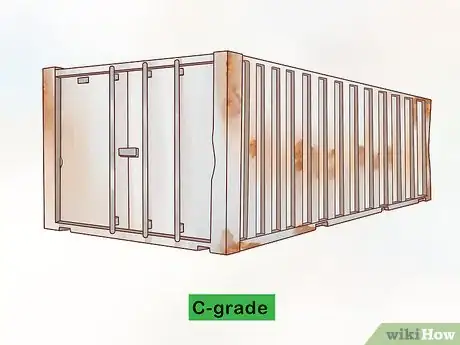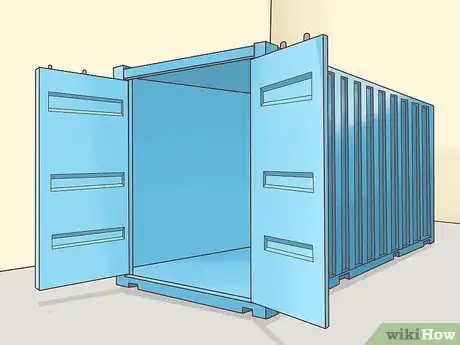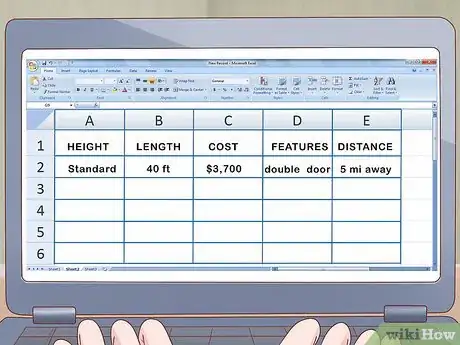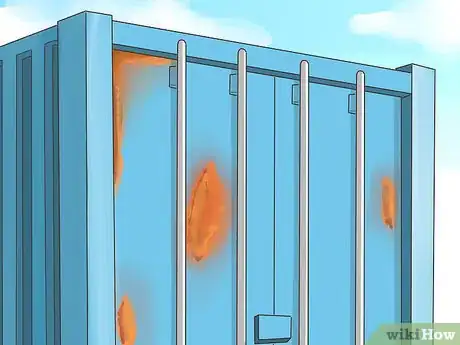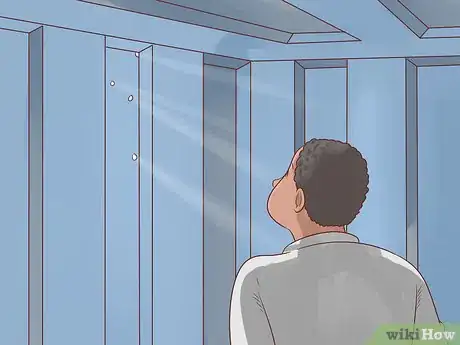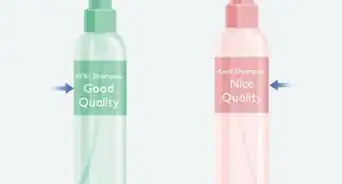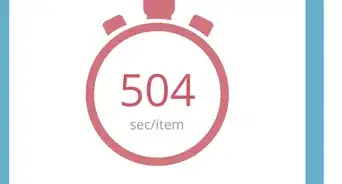This article was co-authored by wikiHow Staff. Our trained team of editors and researchers validate articles for accuracy and comprehensiveness. wikiHow's Content Management Team carefully monitors the work from our editorial staff to ensure that each article is backed by trusted research and meets our high quality standards.
There are 10 references cited in this article, which can be found at the bottom of the page.
wikiHow marks an article as reader-approved once it receives enough positive feedback. This article received 34 testimonials and 94% of readers who voted found it helpful, earning it our reader-approved status.
This article has been viewed 654,084 times.
Learn more...
A shipping container is a modular metal unit often used to transport goods by sea or land. They are commonly built from steel, making them very durable and weather-resistant. You can convert a shipping container into your own storage unit, office, or home. To buy a container, first pick your size, model, and desired features, search online for a seller, and inspect the unit. Then, purchase the shipping container and arrange for delivery. With some planning and research, you can easily own your own shipping container.
Steps
Picking Your Shipping Container Type
-
1Ensure you can store the shipping container on your property. If you live in a city, you’ll likely need a permit from the housing authority to keep the shipping container on personal or business properties. If your home or office is in a highly-trafficked area or residential location, ask your city, county, or neighborhood association about getting a permit.[1]
- If you live on an agricultural property or somewhere that does not get a lot of traffic, you likely don’t need a permit.
-
2Pick between a “Standard” and “High Cube” shipping container. “Standard” containers are usually 8 ft 6 inch (2.59m) tall, while “High Cube” containers are 9 feet (2.7 m) 6 in (2.90m) tall. High Cube containers are slightly more expensive, but they seem a bit more roomy since you have an extra foot of space.[2]
- You can make your decision based on personal preference and sizing requirements.
- These are the most common sizing options, though custom containers are available for additional costs.
Advertisement -
3Choose a unit that is between 6 ft (1.83m) and 40 ft (12.2m) long. You can find used shipping containers in a wide variety of sizes, though 20 ft (6.1m) or 40 ft (12.2m) units are the most common for personal or business spaces. Make your decision based off of the size of your space and how big of a space you’d like.[3]
- Sometimes you can find extra-wide containers, which measure up to 48 feet (14.6m) in length.[4]
- For example, you can choose a standard 40 ft (6.1m) shipping container for a comfortable home option for 2 or so people.
-
4Select an “A-grade” container if you want a nearly-new option. “A” grade shipping containers are in the best condition, and their price tag is usually a little higher as a result. These containers may only be used once or a few times to be considered “used.” Select this option if price is not an option and you want the best looking shipping container.[5]
- ”A-grade” containers often have a fresh paint job, no or minimal dents, and ultimate waterproofing protection.
-
5Choose a “B-grade” container if you don’t mind a few dings and dents. “B-grade” shipping units likely have been used several times but are still in great shape. These may have a few cosmetic imperfections but otherwise are completely weatherproof and durable.[6]
- This is a great option if you want a sturdy container but don’t want to break the bank.
- ”B-grade” containers may have a few dents on the outside and minor rusting in some spots.
-
6Opt for a “C-grade” container for an economical option. “C-grade” shipping containers are the cheapest option, but they may not be in the best of shape. These containers may not be completely waterproof and have many exterior imperfections. If you choose a “C-grade” unit, you may have to do some work on it to make it an office space or home.[7]
- These containers may work better as a storage solution. However, make sure any holes are covered, as water could get inside and ruin your items.
-
7Decide on your container type based on what features you desire. Choose features such as 1 door, double doors, windows, flooring, air conditioning, heating, shelving, internal locking system, and/or outdoor locking options. Since you are buying used, you may not be able to get every feature on your list, but this can help steer you in the direction of the best unit.[8]
- For example, you can search for “A-grade” storage units that have double doors, air conditioning, and flooring. However, you may only find a used “A-grade” container with double doors and air conditioning. In this case, you’ll have to do the flooring yourself.
Finding the Shipping Container
-
1Search online for used shipping containers for sale. This is the easiest way to find a used shipping container for sale. Look up keywords like, “Used shipping container near me,” and browse units for sale. You can find shipping containers for sale through container companies or individual people.[9]
- It’s helpful to have a budget in mind when you shop so you can narrow down your options.
- When browsing options, keep in mind your location in proximity to the container. You’ll have to factor in cost to transport the unit as well. If it’s more than a few miles away, it could cost a lot.
-
2Make a spreadsheet if you want to easily compare units. While this is not required, it can be really helpful when browsing lots of shipping containers. Use a program such as Excel to keep track of the shipping containers you are interested in. Make a column for the height, length, cost, features, distance, and seller information. Then, plug in your information as you search for options.
- For instance, you can write “Standard, 40 ft (12.2 m), $3,700 (£2845.56), 5 mi away, Craigslist.
-
3Call the seller when you find a container you like. After you narrow down your options, dial the contact number listed online, and ask if the unit is still available. If it is, set up a time to come look at the shipping container. Pick a time that works with both of your schedules, and be prepared to buy the shipping container that day.
- When you call, you can say something like, “Hi there, I’m interested in the “B-grade” shipping container advertised on your website. Is it still available?”
Inspecting the Shipping Container
-
1Meet with the seller to inspect the container’s condition. When you meet the seller to see the unit, be sure to do a thorough inspection of the shipping container. This way, you can ensure it is exactly as described online and there aren’t any dealbreakers. Go around the outside and inside of the shipping container looking for imperfections or inconsistencies.[10]
-
2Check door seals and handles to make sure they are well intact. To check this, open the door completely and shut the door securely. You want the door to completely seal without letting any air in. If you have any problems doing this, the lining of the seal may be messed up and need repair. This is especially important if you want to convert the container into a home or office space.[11]
- This may not be a dealbreaker for you, but it's something to consider when totaling your expenses.
- You can also open and close the door from the inside to ensure it seals right from both directions.
-
3Look for any surface rust around the container. Do a surface inspection around the entirety of the container, and in particular, check for rust around the door frame and top of the unit, as this is where water may be able to get in. Rusty spots often signal weak metal, which can result in holes over time. Choose a shipping container with minimal rust if you can.[12]
- If you want your unit to be as waterproof as possible, choose a unit with little rust.
-
4Inspect the inside of your shipping container for any signs of light. Go inside the shipping container and close the door behind you. Look around all of the walls and along the ceiling for any sign of light peeking through. Light can only get through from a hole in the container, and if light can get through, so can water.[13]
- If you find substantial holes in the unit, you’ll have to patch them before you convert the container.
- If there are a few small holes, that’s an easy fix with some putty or caulking. If you find many holes or a few large spots, you may want to reconsider this storage unit.
Purchasing and Delivering the Unit
-
1Negotiate the price of the shipping container with the seller. Oftentimes, sellers need to get rid of space quickly to prevent old shipping containers from piling up. As a result, you can usually talk them down in price to take the container off their hands, based on the imperfections you find. If they won’t budge in price, ask for free delivery instead, if you are buying from a company.[14]
- For instance, ask the seller if they’ll take the container for $200 (£153.81) less than the asking price due to the exterior rust.
-
2Purchase your shipping container from the company or individual seller. Once you’ve agreed upon price, pay with either cash or card, depending on the seller’s preference. If you are buying from a company, they likely accept either method. If you’re buying from an individual, they’ll likely prefer cash.[15]
-
3Arrange for delivery with the company if possible. After you handle payment, it’s time to bring your unit home! If you’re buying from a company, they likely have a delivery service available, and they can go over the next steps with you after you check out.[16]
-
4Suppose you have arranged to receive shipping containers at your site. In that case, it's important to understand what the delivery team is expected at your end. Although designed for easy delivery, if your property or site is not prepared correctly, your shipping container company might not be able to complete the delivery as planned. When this happens, although the company can't charge you for the container's cost, they can charge you for delivery. [17]
- You may have to pay a delivery fee in addition to the cost of the unit.
-
5Find a delivery company online if buying from a private seller. To find a delivery company, search online for something like “storage unit delivery service near me,” and browse your options. Call the companies you’re interested in and ask for a pricing quote, based off of your location and the size of the unit. Then, schedule a time and date for the delivery based on your schedule.
- Some companies will give you various price quotes. You can go with the quote that best fits into your budget.
Community Q&A
-
QuestionCan I buy a second-hand container?
 Community AnswerYes, you can but you should be aware of possible rust and corrosion. Do not forget that they travel sometimes through harsh weather and salty water is a powerful corrosive.
Community AnswerYes, you can but you should be aware of possible rust and corrosion. Do not forget that they travel sometimes through harsh weather and salty water is a powerful corrosive. -
QuestionWhere can I find a used container?
 Community AnswerTry in your local area first; there maybe a shipping container dealer nearby. You can also try searching ads in your local newspaper. Lastly, you can always search online, such as eBay.
Community AnswerTry in your local area first; there maybe a shipping container dealer nearby. You can also try searching ads in your local newspaper. Lastly, you can always search online, such as eBay. -
QuestionHow much does it cost to ship?
 Community AnswerAnywhere from $500 to $3000.00 -- it depends on the distance. Also, if the transporting company is allowed to load the container for part of the trip, they may be willing to work with you on the price.
Community AnswerAnywhere from $500 to $3000.00 -- it depends on the distance. Also, if the transporting company is allowed to load the container for part of the trip, they may be willing to work with you on the price.
References
- ↑ https://www.360mobileoffice.com/storage-containers/how-to-buy-used
- ↑ https://www.containerhomeplans.org/2015/02/how-to-purchase-your-shipping-containers/
- ↑ https://youtu.be/6em6PIOISFQ?t=12s
- ↑ https://www.containerhomeplans.org/2015/02/how-to-purchase-your-shipping-containers/
- ↑ https://youtu.be/djaNVmKq2LQ?t=3m30s
- ↑ https://youtu.be/djaNVmKq2LQ?t=3m
- ↑ https://youtu.be/djaNVmKq2LQ?t=3m54s
- ↑ https://www.360mobileoffice.com/storage-containers/how-to-buy-used
- ↑ https://www.containerhomeplans.org/2015/02/how-to-purchase-your-shipping-containers/
- ↑ https://www.containerhomeplans.org/2015/02/how-to-purchase-your-shipping-containers/
- ↑ https://youtu.be/C_p8Edbin0o?t=50s
- ↑ https://youtu.be/C_p8Edbin0o?t=50s
- ↑ https://youtu.be/C_p8Edbin0o?t=1m10s
- ↑ https://offgridworld.com/10-things-you-need-to-know-before-you-buy-a-container/
- ↑ https://www.360mobileoffice.com/storage-containers/how-to-buy-used
- ↑ https://www.360mobileoffice.com/storage-containers/how-to-buy-used
- ↑ https://www.sigmacontainer.ca/products-and-services/container-rentals/
- ↑ https://www.360mobileoffice.com/storage-containers/how-to-buy-used
About This Article
If you want to buy a used shipping container, search online to find used shipping containers for sale. It’s useful to know what type of shipping container you would like and what your budget is before you start shopping. If you find multiple units for sale, make a spreadsheet to compare the containers to help you decide which one you want. Call the seller and, if possible, view the container in person before making your final decision. For tips on inspecting the shipping container, like checking the door seals, read on!





